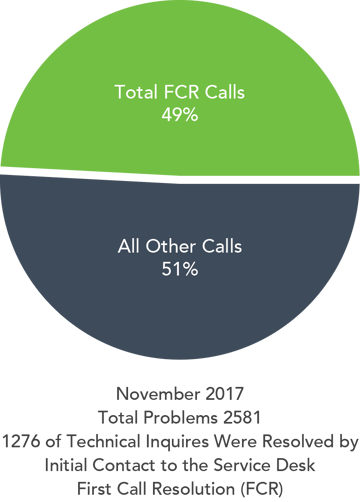
There are two easy ways for IT to help their company destroy customer loyalty:
- Force customers to trudge their way through a maze of dial up numbers or prolonged chat session queues
- Require them to do it all over again because their issue still isn’t resolved
Obviously, these are not our goals. Therefore, the risk of losing customer trust is sufficient to drive drastic and transformative changes to improve FCR IT – First Call Resolution or First Contact Resolution (FCR). FCR is a KPI that describes how many customers had their issues resolved during their initial interaction with your helpdesk. It is a critical indicator, within a vast sea of incident metrics.
For phone support, this means issue resolution during the first call; for online support, this means issue resolution during the same chat session or the first email response. According to a recent research by SQM Group, improving first call resolution by every single percent translates into the same magnitude of improvement in customer satisfaction.
Forward Looking Management and Measurement
Organizations must understand a key fact when it comes to customer experiences: the customer’s impulse to punish a poor service far outweighs their desire to patronize a good service. Instead of leaving your agitated customers at the mercy of AI chatbots and overwhelming them with possible (but often misdirected) self-service troubleshooting options, it’s important to for you to identify the root cause of their problems while eliminating the amount of effort that is required by the customer.
With this in mind, it’s easy to understand why FCR IT is valuable in identifying the direct impact of IT issues on customer satisfaction. For IT Operations and Support, FCR as an incident metric also holds invaluable situational insights on your overall performance.

But reviewing the metrics is by definition a reactive exercise. Success in meeting modern FCR goals depends on developing proactive event management and incident resolution capabilities. To do so, your organization needs to:
1. Integrate the Tooling
FCR IT performance is compromised due to the growing disconnect between ITOps and IT Service Management professionals. Integrated monitoring is required to ensure that complementary incident resolution efforts are realized between these otherwise siloed entities. Deploying a myriad of stand-alone tooling doesn’t help to achieve those objectives. Instead, IT Operations Managers and service personnel need an intelligent system that improves communication, accountability and visibility into the infrastructure by integrating all monitoring data from all systems.

2. Scale Monitoring and Event Management
IT incidents (and tickets) represent the issues that are causing service disruptions for your customers. To understand how complicated it can be to diagnose problems and improve FCR, let’s peel back the incident layer a bit.
Incidents are made up of events. Events are created by alarms and alerts coming from your monitoring tools. Those tools are also generating massive amounts of metric data and tons of log files that may need to be parsed during problem solving. To make matters worse, monitoring keeps expanding to keep up with business needs and technology shifts around cloud computing, IoT, microservices, etc. Ultimately, this wave of scalable innovation fuels complexity for IT operations, making it difficult for them to quickly and accurately identify issues.
Most organizations are wrestling with their ability to process exploding volumes of events data. Those with legacy event management systems and custom-built tools are especially challenged to find actionable intelligence, which can be used to remediate service impact. The modern enterprise needs to leverage pre-packaged AIOps solutions that are designed to meet evolving, scalable and often unpredictable demands through machine learning and preconfigured logic.
3. Understand the Big Picture
Incident resolution models that treat metrics as isolated sources of information fail to see the big picture. Combined together, seemingly isolated sets of events can describe patterns that point to a common root cause. However, identifying event patterns alone may not suffice in establishing models for proactive, real-time incident resolution.
You should also incorporate additional ITSM data to further enrich events and improve intelligence. For example:
- Your CMDB is a data set that can help reveal service impact
- Prior Incident data can show actual severity (which can then be used to accurate rank events based on anticipated impact)
- Change management may indicate that large volumes of alerts are coming from planned activities. These could easily be suppressed, enabling your team to focus on relevant, actionable events instead

4. Intelligent Event Noise Suppression and Beyond
Once you have established a single pane of glass, and connected your monitoring and ITSM systems, you’ll be in good shape to apply filtering, deduplication and advanced correlation logic. But there’s more.
Evanios can add a specific priority score to every event, helping your team see exactly where they should be focusing their effort. Plus, our intelligent, automated AIOps system can use enriched event data to trigger incident resolution, thereby improving first call resolution.
Further, your team will no longer have to waste time scripting rules. Instead, Evanios preconfigured logic and advanced machine learning algorithms will provide accurate predictive analytics (early indicators of more serious incidents) and automated root cause analysis. You’ll be able to get to work solving issues, before users are even aware that there was a (potential) problem.
With these necessary capabilities in place, you’ll be able to significantly reduce outages and reduce Mean Time To Repair. This will lead to improved first call resolution, and better overall customer satisfaction.
Evanios will help you improve first call resolution. For additional information, download our capabilities brochure, or contact us for a demo.




